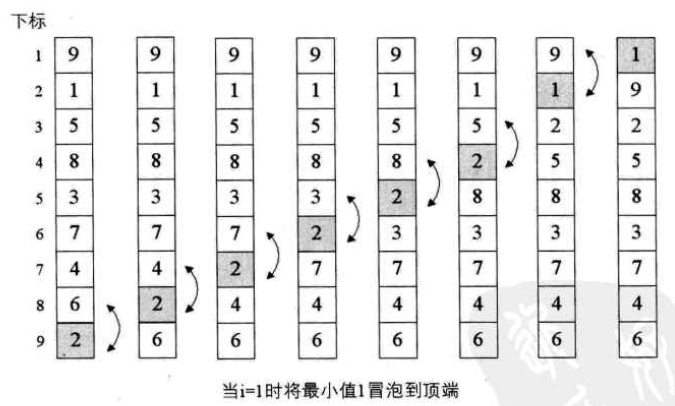冒泡排序(Bubble Sort)一种交换排序,它的基本思想是:俩俩比较相邻记录的关键字,如果反序则交换,直到没有反序的记录为止。
最简单排序实现
原理
让每一个关键字,都和它后面的每一个关键字比较,如果大则交换,直到结束。如图:

算法
#include "stdafx.h"
using namespace std;
#include<iostream>
#include"stdafx.h"
//用于要排序数组个数最大值,可根据需要修改
#define MAXSIZE 10
typedef struct
{
//用于存储要排序数组,r[0]用作哨兵或临时变量
int r[MAXSIZE + 1];
//用于记录顺序表的长度
int length;
}SqList;
//交换L中数组r的下标为i和j的值
void swap(SqList *L, int i, int j) {
int temp = L->r[i];
L->r[i] = L->r[j];
L->r[j] = temp;
}
//对顺序表L作交换排序(冒泡排序初级版)
void BubbleSort0(SqList *L) {
int i, j;
for (i = 1; i<L->length; i++) {
for (j = i + 1; j <= L->length; j++) {
if (L->r[i]>L->r[j]) {
//交换L->r[i]与L->r[j]的值
swap(L, i, j);
}
}
}
}
#define N 9
int main()
{
int d[N] = { 9,1,5,8,3,7,4,6,2 };
SqList L0;
for (int i = 0; i < N; i++) {
L0.r[i + 1] = d[i];
}
L0.length = N;
cout<< "排序前:";
for (int j = 1; j <= L0.length; j++) {
cout<< L0.r[j];
}
BubbleSort0(&L0);
cout << "\n初级冒泡排序:";
for (int j = 1; j <= L0.length; j++) {
cout << L0.r[j];
}
cout << endl;
return 0;
}运行结果

冒泡排序算法
原理
俩俩比较相邻记录的关键字,如果反序则交换,直到没有反序的记录为止。如图:

算法
#include "stdafx.h"
using namespace std;
#include<iostream>
#include"stdafx.h"
//用于要排序数组个数最大值,可根据需要修改
#define MAXSIZE 10
typedef struct
{
//用于存储要排序数组,r[0]用作哨兵或临时变量
int r[MAXSIZE + 1];
//用于记录顺序表的长度
int length;
}SqList;
//交换L中数组r的下标为i和j的值
void swap(SqList *L, int i, int j) {
int temp = L->r[i];
L->r[i] = L->r[j];
L->r[j] = temp;
}
//对顺序表L作交换排序(冒泡排序版)
void BubbleSort(SqList *L) {
int i, j;
for (i = 1; i<L->length; i++) {
//注意j是从后往前循环
for (j = L->length-1 ; j >=i; j--) {
//若前者大于后者
if (L->r[j]>L->r[j+1]) {
//交换L->r[j]与L->r[j+1]的值
swap(L, j, j+1);
}
}
}
}
#define N 9
int main()
{
int d[N] = { 9,1,5,8,3,7,4,6,2 };
SqList L0;
for (int i = 0; i < N; i++) {
L0.r[i + 1] = d[i];
}
L0.length = N;
cout<< "排序前:";
for (int j = 1; j <= L0.length; j++) {
cout<< L0.r[j];
}
BubbleSort(&L0);
cout << "\n冒泡排序后:";
for (int j = 1; j <= L0.length; j++) {
cout << L0.r[j];
}
cout << endl;
return 0;
}运行结果

冒泡排序优化
原理
增加一个标记变量flag来实现冒泡算法的改进。可以避免因已经有序的情况下的无意义循环判断。

算法
#include "stdafx.h"
using namespace std;
#include<iostream>
#include"stdafx.h"
//用于要排序数组个数最大值,可根据需要修改
#define MAXSIZE 10
typedef struct
{
//用于存储要排序数组,r[0]用作哨兵或临时变量
int r[MAXSIZE + 1];
//用于记录顺序表的长度
int length;
}SqList;
//交换L中数组r的下标为i和j的值
void swap(SqList *L, int i, int j) {
int temp = L->r[i];
L->r[i] = L->r[j];
L->r[j] = temp;
}
//对顺序表L作交换排序(优化的冒泡排序版)
void BubbleSort(SqList *L) {
int i, j;
//flag用来作为标记
bool flag = true;
//若flag为true则退出退出循环
for (i = 1; i<L->length&&flag; i++) {
//初始为false
flag = false;
//注意j是从后往前循环
for (j = L->length-1 ; j >=i; j--) {
//若前者大于后者
if (L->r[j]>L->r[j+1]) {
//交换L->r[j]与L->r[j+1]的值
swap(L, j, j+1);
//如果有数据交换,则flag为true
flag = true;
}
}
}
}
#define N 9
int main()
{
int d[N] = { 9,1,5,8,3,7,4,6,2 };
SqList L0;
for (int i = 0; i < N; i++) {
L0.r[i + 1] = d[i];
}
L0.length = N;
cout<< "排序前:";
for (int j = 1; j <= L0.length; j++) {
cout<< L0.r[j];
}
BubbleSort(&L0);
cout << "\n优化后的冒泡排序后:";
for (int j = 1; j <= L0.length; j++) {
cout << L0.r[j];
}
cout << endl;
return 0;
}运行结果

冒泡排序复杂度分析
冒泡排序时间复杂度为O(n^2)
算法稳定性
稳定






















 4535
4535

 被折叠的 条评论
为什么被折叠?
被折叠的 条评论
为什么被折叠?








